Sep 11, 2009
How Wishful Thinkers Are Forced To Reconnect With Energy Reality
By Peter C. Glover and Michael Economides, Investor’s Business Daily
You couldn’t make it up even if you tried:
One day Energy Secretary Ed Milliband sets out his proposed expansion of the U.K.’s wind power-led alternative energy revolution; the next day, Vestas, the U.K.’s largest wind turbine manufacturer, shuts down a big part of its British operations citing “low demand” and public opposition to onshore wind farms.
Just bad luck or bad PR? Not quite. Simply another blatant example of the ongoing “disconnect” over energy between those suffering from WTS (Wishful Thinker Syndrome) and the hydrocarbon-fueled present and future energy realities.
In 2006, Germany’s Angela Merkel was hailed as the “Green Chancellor” for promising to rid her country of coal and nuclear power in its bid to give a clean energy “world lead.” Three years on and Merkel’s government actively supports the construction of a new generation of 26 coal-fired power plants as well as keeping Germany’s nuclear power stations open. In addition she wants special protection for German heavy industry via free cap-and-trade permits. A powerful German industry, the need to remain competitive and a desire to work with the lights on all combined to help Ms. Merkel “reconnect.”
In 2008, Italy, to everyone’s surprise, reversed its decades-long “no nuclear power stations” policy in the interest of its power needs. And Italy’s Prime Minister, Silvio Berlusconi, along with leaders from Austria, Poland and a rolling bandwagon of other countries, also now demands protection for its heavy industry when it comes time to handing out free cap-and-trade permits.
Across in the U.K., the government has been wriggling out of its “clean energy” commitments for years as the country inches toward building an urgently needed new generation of coal-fired power plants. To help critics swallow the bitter pill of yet more coal usage, the U.K. government is subsidizing “clean coal” technology strategies via CCS (carbon capture sequestration). But adding $1 billion to the cost of each plant for a hugely speculative unproven technology has already created a politically paralyzing impasse in the U.K. energy strategy.
The specter of the U.K. facing “South African-style power cuts” and being plunged into “Third World darkness” now looms. Hence the U.K.’s grand wind power plan. Unfortunately, last December, the British Wind Energy Association was forced to scale down its calculation of harmful CO2 emissions “displaced” from 860 to 430 grams for every kilowatt hour of electricity produced.
In fact, with fewer than 2,400 wind turbines in operation across Britain currently, the U.K. would still require a further 100,000 to meet its targets. Plenty of scope for massive wind turbine growth, we might think. So why the Vestas pullout?
Not that Eurocrats are easily deflated by wind power facts on the ground. Speaking at a key European wind power conference in March 2009, EU Energy Commissioner Andris Piebalgs claimed:
“Wind energy can replace a large proportion of the polluting and finite fuels we currently rely on. It makes good sense to invest in indigenous sources of power, which hedge against unpredictable fossil fuel prices and in which Europe has a real competitive advantage.” He added: “Wind energy is Europe’s contribution to peace, progress and prosperity.”
Mr. Piebalgs’ claims entirely epitomize the energy disconnect. As University of Toronto law professor Michael J. Trebilcock has shown, wind power is a complete disaster with the much-vaunted “Danish green energy miracle” turning out to be a well-worn myth in an industry that would blow out tomorrow without ongoing and massive public subsidy. And all this is for an energy source that will, in the next few decades, provide only a tiny amount of the world’s power.
“Capitalism and consumerism have brought the world to the brink of economic and environmental collapse,” the U.K.’s Prince of Wales ruminates, adding that “the age of convenience is over.” As international columnist Mark Steyn comments, “The Prince then got in his limo and was driven to his other palace.”
Today, the Obama White House is recycling all the same European political energy rhetoric so familiar to Europeans. Yet, the U.S. has its own instructive case study. One day billionaire T. Boone Pickens has a Grand Wind Plan for Texas, with further plans to forest the nation with turbines “from Canada to Mexico.” The next, T. Boone drops his wind plan in favor of .. . a hydrocarbon (natural gas) solution instead.
As we have seen, however, national leaders will ultimately refuse to impoverish their industries even to “save the planet.” The still-"disconnected" flower-power generation and its idealistic offspring would do well to grasp that the energy future is not green. It is hydrocarbon, and will continue to be for another century at least. Perhaps it’s just that we have yet to learn a language they’ll understand? Maybe we should run the energy stats past them one more time, make a peace V-sign and (gently) ask: “Reconnected yet, man?”
Economides is editor-in-chief and Glover is Europe associate editor of the Energy Tribune.
Sep 10, 2009
Wash. Post’s Own Meteorologist Counters Paper’s Claims! ‘I wince when hearing…science is ‘settled’
By Marc Morano, Climate Depor and Matt Rogers
Climate Depot’s Editor’s Note: The Washington Post’s Andrew Freedman has his hands full. After declaring on September 1, 2009, that “increasing climate change skepticism among the public is troubling” because “it flies in the face of most of the scientific evidence,” Freedman now faces a fellow Washington Post “Capital Weather Gang” member—Meteorologist Matt Rogers - who is openly rebelling from Freedman’s stated climate views. Just days after Freedman’s public feud with Climate Depot over climate science, the Washington Post’s Rogers declared his strong climate skepticism on the paper’s
“Capital Weather Gang” site on September 10, 2009, titled “A Skeptical Take on Global Warming.”
Freedman had attacked Climate Depot as being “anti-science and anti-science journalism.” But after two lengthy rebuttals from Climate Depot, Freedman threw in the towel and refused to defend his climate views any further. Freedman appears so afraid of defending his global warming assertions, that he declined a TV news show’s offer to a one-on-one debate with Climate Depot’s executive editor (me, Marc Morano). Freedman refused to debate on Clean Skies TV, even though I instantly agreed to the debate offer. Freedman instead demanded to appear on the TV show separately on a completely different day than my appearance. (Sadly, most --but not all—global warming fear promoters duck scientific debates. See: Morano debates former Clinton Official Romm - April 6, 2009)
Freedman had written that he is so convinced of the alleged “consensus” about man-made global warming fears that he declared not acting to prevent a climate catastrophe “would be a stunning act of defiance against the climate science community that has firmly concluded that mankind is disrupting the climate system.” [See: 1) Shock: Wash. Post Blames Obama For Failure of Global Warming Movement! President’s ‘mistakes may cost the planet dearly’ - September 1, 2009 2) - Wash. Post Fires Back: Accuses Climate Depot of having ‘an anti-science and anti-science journalism agenda!‘—Climate Depot Responds - September 2, 2009 - 3) World-Wide Reaction to Climate Depot’s Public Climate Clash with the Washington Post - September 4, 2009 ] But it now appears that instead of attacking Climate Depot for its reporting on the latest climate science, Freedman will be forced to respond to his own “Weather Gang” team members. End Editor’s Note.]
Wash. Post’s Own Meteorologist Counters Paper’s Claims! ‘I wince when hearing...science is ‘settled’—Climate ‘hysteria’ may be ‘another bubble waiting to burst’ - September 10, 2009
Washington Post Meteorologist Matt Rogers, co-founder of the Commodity Weather Group, LLC, and previously Director of Weather for MDA EarthSat Weather, referenced Freedman’s recent assertions about the man-made global warming issue being “settled.” “I respect Andrew Freedman and his beliefs. We have had a number of discussions both publicly and privately regarding our differing viewpoints, and he has been nothing but respectful and professional,” Rogers wrote on September 10, 2009.
Key Excerpts from Washington Post Meteorologist Matt Rogers: There are numerous reasons why I question the consensus view on human-induced climate change covered extensively on this blog by Andrew Freedman. [...] Several times during debates individuals have told me I should not question the “settled science” due to the moral imperative of “saving the planet”. As with a religious debate, I’m told that my disagreement means I do not “care enough” and even if correct, I should not question the science. This frightens me. [...] My belief is that they are over-estimating anthropogenic (human) forcing influences and under-estimating natural variability (like the current cold-phase Pacific Decadal Oscillation and solar cycles) [...] To be blunt, the computer models that policy-makers are using to make key decisions failed to collectively inform us of the flat global land-sea temperatures seen in the 2000s. [...] The argument that the air we currently exhale is a bona fide pollutant due to potential impacts on climate change flummoxes me. CO2 is also plant food. [...] As a meteorologist, verification is very important for guiding my work and improving future forecasts. The verification for global warming is struggling. Three of four major datasets that track global estimates show 1998 as the warmest year on record with temperatures flat or falling since then. Even climate change researchers now admit that global temperature has been flat since that peak. [...] The coincident timing of major solar minimums with cooler global temperatures (such as during the Little Ice Age) suggests that maybe the sun is underestimated as a component for influencing climate. [...] Indeed, recent research has suggested the solar factor is underestimated (here and here). Perhaps one day, we’ll have a different version of James Carville’s famous political quote...something like “It’s the sun, stupid!” [...] Does climate change hysteria represent another bubble waiting to burst? From the perspective of the alarmism and the saturation of the message, the answer could be yes. [...] I believe that predictions of human-caused climate change will continue to be overdone, and we’ll discover that natural factors are equally and sometimes even more important.
To read Washington Post “Capital Weather Gang” Meteorologist Matt Roger’s complete 10 point essay on why he rejects man-made climate fears. Go here.
Good for you Matt. There is at least one member with climate sense on the gang after all.
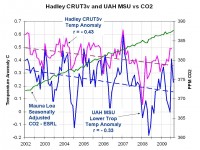
Sep 08, 2009
Excerpts from a scientific paper by Dr Martin Hertzberg
By Dr Martin Hertzberg
Martin Hertzberg 2009, “Earth’s radiative equilibrium in the solar irradiance”, Energy & Environment v.20 no.1&2, pp.85-96 (Special double-issue: Natural drivers of weather and climate, 278p.)
“Many interacting regions, both homogeneous and heterogeneous, are involved in the complex radiative balance. Unverified models do not realistically represent that balance, and it would be absurd to base public policy decisions on them.
“… the controlling factor in determining the average temperature of the Earth is its absorptivity to emissivity ratio.
Even for those portions of Earth that are not covered with clouds, the assumption that the ocean surface, land surfaces, or ice and snow cover would all have blackbody emissivities of unity, is unreasonable.
It is certainly true that in the absence of an atmosphere, temperatures would drop drastically at night as the darkened portions of Earth lost infrared energy by radiation to Space; however, with all the incoming solar radiation being concentrated on the daytime half of the surface, daytime temperatures would rise as drastically as the night time temperatures would fall.
If the near-surface air temperature is not representative, is it realistically possible to measure the average temperature of the entire mass of absorbing and emitting entities with sufficient accuracy to make a meaningful comparison between the data and the predictions?
How high in altitude should one go in the atmosphere to include it all?
Similarly, how deep in the liquid fluid of the oceans should one go in order to include the mass below the ocean surface that influences the heat and mass transport processes near the ocean surface and in the atmosphere above it?”
“… looking at the problem in depth, it may be more realistic to conclude that its resolution may be unattainable given our limited understanding of the complex processes involved, and the lack of data available for the current thermodynamic state of those entities.
The heat and mass transport from that enormous ocean reservoir to the atmosphere are the dominant factors in determining temperatures and weather conditions over the entire globe.
It is implausible to expect that small changes in the concentration of any minor atmospheric constituent such as carbon dioxide, can significantly influence that radiative equilibrium.
Further quotes by this accomplished research scientist:
“In 1994 I tried to get an analysis of the then prevalent state of climate science published in Nature and Science, but they weren’t interested. I even sent a copy of it with a long letter to Burt Bolin, who was then chair of the IPCC. He replied to the effect that who was I to challenge the decades of work of so many distinguished scientists. He also argued that I was being disrespectful by referring to the some of the theories of the global warming advocates as “catechisms”. After studying the issue more carefully and reading the well researched papers of the skeptics/realists, I now think that the AGW arguments do not deserve to be referred to as either “theories” or “catechisms”. In reality, they are elaborate hoaxes.”
“I tried explaining to [those] Senators that in order for them to accept the Gore-IPCC-Hansen theory as valid, they will first have to repeal the Second Law of Thermodynamics!”
Compiled by Hans Schreuder, 7 September 2009
Sep 06, 2009
August 2009 Global Temperature Update: +0.23 degrees C
By Dr. Roy Spencer

See larger image here.
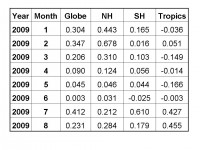
See larger table here.
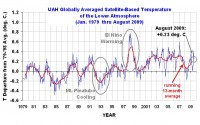
See larger image here.
August 2009 saw a modest fall in the global average tropospheric temperature anomaly, from +0.41 deg. C in July to +0.23 deg. C in August. The tropical and Northern Hemispheric troposphere remain quite warm, but the Southern Hemisphere cooled by over 0.4 deg. C in the last month.
NOTE: For those who are monitoring the daily progress of global-average temperatures here, we are still working on switching from NOAA-15 to Aqua AMSU, which will provide more accurate tracking on a daily basis. We will be including both our lower troposphere (LT) and mid-tropospheric (MT) pre-processing of the data. We will also be adding global sea surface temperature anomalies from the AMSR-E instrument on board the NASA Aqua satellite.
Global Oceanic Climate Update for August 2009
This is the first of what might turn into a series of monthly updates of some maritime climate parameters monitored by the AMSR-E instrument on NASA’s Aqua satellite. All monthly statistics have been computed by me from daily global gridpoint data produced and archived by Remote Sensing Systems (RSS) under the direction of Frank Wentz, a member of our U.S. AMSR-E Science Team. Since Aqua was launched in 2002, the data are available only since June, 2002. A description of how these products were derived, and where they reside, is provided here.
There are 5 “ocean products”: sea surface temperature [SST]; near-surface wind speed; vertically-integrated water vapor; vertically integrated cloud water; and rain rate. I will present time series of monthly anomalies averaged over the global, ice-free oceans (56 deg. N to 56 deg. S latitude), and separately for the deep tropics (20 deg. N to 20 deg. S latitude). ‘Anomalies’ are departures from the average seasonal cycles in those parameters, which will be recomputed as each new month of data is added.
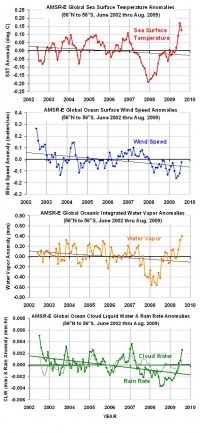
See larger image here
How these different variables change relative to each other is illustrated in the following lag-correlation plot of SST versus the other variables. “PDO” is the Pacific Decadal Oscillation Index, while “SOI” is the Southern Oscillation Index (negative for El Nino, positive for La Nina). A discussion of these curves is provided later, below.
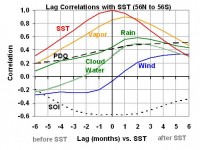
DISCUSSION
Using the 20N-20S lag correlation plot as an example, you can see that total integrated water vapor is highly correlated with SST, which in turn is highly correlated with El Nino conditions (negative SOI values). Also note that sea surface temperature tends to peak after months of anomalously low wind conditions, then falls as wind speeds increase. Cloud water and rain rates increase as SST increases, reaching a maximum 1 to 3 months after the SST peaked. Read more on tropical SST analyses here.
The following is the monthly USH global plot versus the ESRL CO2.
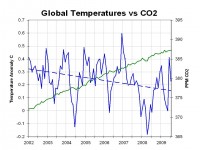
See larger image here
Sep 04, 2009
Not Again! Media Now Promoting Arctic ‘Hockey Stick’ - Scientists Already Rebuking Latest Study
Marc Morano, Climate Depot
The new study claims to show “human-generated greenhouse gas emissions have helped reverse a 2,000-year trend of cooling in the Arctic, prompting warmer average temperatures in the past decade that now rank higher than at any time since 1 B.C.,” according to a September 3, 2009 article by the Washington Post’s Juliet Eilperin. The study will appear in the September 3, 2009 online version of the journal Science. The lead author was Northern Arizona University professor Darrell S. Kaufman.
The Washington Post also saw fit to gave prominent play to the environmental group World Wildlife Fund’s new dire Arctic study claiming a scary global warming caused “transformation” of the Arctic. The Post article on the new Arctic “Hockey Stick” completely glossed over years of contrary data and instead mostly gave the authors a scrutiny free ride. (Eilperin also misspelled the name of one scientist she quoted.)
MIT climate scientist Dr. Richard Lindzen told Climate Depot, “This looks like this week’s “Hockey Stick” including many of Mann’s collaborators.” [Editor’s Note: Mann’s has attempted multiple “Hockey Stick” inventions and his newest creation is the Hurricane “Hockey Stick”.]

Ice Mann enlarged here.
Climate data analyst Steve McIntyre who publishes Climate Audit and is known for his research discrediting Mann’s original “Hockey Stick” temperature graph, weighed in on the new Arctic study. “Amusingly, the [Arctic study’s lead author] Kaufman Team perpetuates Mann’s upside down use of the Tiljander proxy,” McIntyre wrote on September 3, 2009. “You can readily see that this closely matches the Mann version,” McIntyre noted. “The most cursory examination [of the study] shows the usual problem of seemingly biased picking of proxies without any attempt to reconcile proxy conflicts,” McIntryre wrote. See also this post showing the cherry picking selection of the proxys with the most hockey stick appearance and other statistical chichanery.
New Peer-Reviewed Study Shows Arctic COOLING Over last 1500 years! - Feb 5, 2008 - Published in Climate Dynamics on 30 January 2008. Excerpt: New Arctic Study published in Climate Dynamics, and the work was conducted by Hakan Grudd of Stockholm University’s Department of Physical Geography and Quaternary Geology - Published online: 30 January 2008 - Excerpt: “The late-twentieth century is not exceptionally warm in the new Tornetrask record: On decadal-to-century timescales, periods around AD 750, 1000, 1400, and 1750 were all equally warm, or warmer.”
Danish Meteorological Institute records show: No Arctic Warming Since 1958! - ‘Arctic was warmer in the 1940s than now’ - May 13, 2009.
U.S. Government Arctic Study: ‘Current rate of human-influenced Arctic warming is comparable to peak natural rates documented by reconstructions of past climates’ - January 16, 2009
January 2008 study in the peer-reviewed journal Science found North Atlantic warming tied to natural variability. Excerpt: A Duke University-led analysis of available records shows that while the North Atlantic Ocean’s surface waters warmed in the 50 years between 1950 and 2000, the change was not uniform. In fact, the sub-polar regions cooled at the same time that subtropical and tropical waters warmed. This striking pattern can be explained largely by the influence of a natural and cyclical wind circulation pattern called the North Atlantic Oscillation (NAO), wrote authors of a study published Thursday, January 3 in Science Express, the online edition of the journal Science. [...] “It is premature to conclusively attribute these regional patterns of heat gain to greenhouse warming,” they wrote.
A November 2007 peer-reviewed study conducted by a team of NASA and university experts found cyclical changes in ocean currents impacting the Arctic. Excerpt: “Our study confirms many changes seen in upper Arctic Ocean circulation in the 1990s were mostly decadal in nature, rather than trends caused by global warming,” said James Morison of the University of Washington’s Polar Science Center Applied Physics Laboratory in Seattle, according to a November 13, 2007 NASA release.
A 2005 peer-reviewed study in Geophysical Research Letters by astrophysicist Dr. Willie Soon, solar irradiance appears to be the key to Arctic temperatures. The study found Arctic temperatures follow the pattern of increasing or decreasing energy received from the sun. Excerpt: Solar forcing explains well over 75% of the variance for the decadally-smoothed Arctic annual-mean or spring SATs (surface air temperatures).
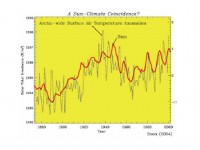
According to a 2003 study by Arctic scientist Igor Polyakov, the warmest period in the Arctic during the 20th Century was the late 1930s through early 1940s. Excerpt: Our results suggest that the decadal AO (Arctic Oscillation) and multidecadal LFO (low-frequency oscillation) drive large amplitude natural variability in the Arctic making detection of possible long-term trends induced by greenhouse gas warming most difficult.
Report: Arctic ‘ice level in the 1920’s, 30’s and early 40’s was at a similar low level’ of today - September 10th, 2008. For many, many more Arctic studies, go to: Climate Depot’s Arctic Fact Sheet - Get the latest peer-reviewed studies and analysis - July 30, 2009
The Post article on the new Arctic study also reported: “The [new Arctic] paper in Science sheds light on several key scientific questions, including how the earth’s orbital pattern around the sun affects our climate, and the extent to which current computer climate models mirror real-world conditions. Some climate skeptics have argued that the fact that the earth wobbles in its axis of rotation has helped determine recent warming, rather than human activities. But the new study shows this wobble—which affects how much sunlight the earth receives in the middle of the summer—actually accounts for a long-term cooling trend in the Arctic, which has only been reversed in the past half-century.”
But geologist Dr. Don J. Easterbrook, Emeritus Professor at Western Washington University, who has authored eight books and 150 journal publications, disputed the findings of new Arctic report. “The glacial record (both advance and retreat history and the isotope data in Greenland ice cores) contrast sharply with the temperature curves shown in this paper,” Easterbrook told Climate Depot. “There is no way that the well documented, short-term climate changes can be orbitally driven because of the vastly longer time scales for orbital changes. Among the big surprises (and most significant) results of the ice core data is that the abrupt, short-term climate changes cannot be possibly be explained by orbital changes,” Easterbrook added.
Singer agreed, noting, “the Abstract tries to relate 20th century temperature changes to insolation changes and claims these are ‘orbitally’ driven. This is highly unlikely: the temperature changes on a time scale of decades; orbital changes are much slower, and generally measured in millennia. I prefer [Harvard University Astrophysicist] Dr. Willie Soon’s analysis of Arctic temperature changes.”
Eilperin then goes on to claim that that the “documentation of the Medieval Warm Period is primarily about Europe, and natural records indicate average Arctic temperatures during that time were not as high. There was a brief period in the early fifth century that came close to, but was not quite as warm, as the Arctic’s most recent summer temperatures.”
How sad, that Eliperin’s refused to do basic research before making such a whopper of a claim. The latest research clearly reveals that the Medieval Warm Period (used to be referred to as the Medieval Climate Optimum) has been verified and was in fact global, not just confined to the Northern Hemisphere. The Center for the Study of Carbon Dioxide and Global Change reported in 2009 that the “Medieval Warm Period was: (1) global in extent, (2) at least as warm as, but likely even warmer than, the Current Warm Period, and (3) of a duration significantly longer than that of the Current Warm Period to date.”
In addition, The Science and Public Policy Institute reported in May 2009: “More than 700 scientists from 400 institutions in 40 countries have contributed peer-reviewed papers providing evidence that the Medieval Warm Period (MWP) was real, global, and warmer than the present. And the numbers grow larger daily.”
After promoting the eco-group World Wildlife Fund’s new climate study, the Washington Post also digs up a scientist with a woeful reputation, Robert Corell, and chooses not to identify his employment with the partisan Heinz Foundation, vice-chaired by Teresa Heinz Kerry, wife of Senator John Kerry (who recently claimed: Global Warming Is The Next 9/11) Eilperin felt compelled to state that Fred Singer was a “skeptic” but the reporter felt no obligation to label any other scientists she cited in the article. Reporter Eilperin wrote: “Robert Correll, who chairs the Arctic Climate Impact Assessment, said the paper in Science will likely ‘in the long haul become a seminal piece in the scientific literature” because it allows other climate researchers “to set their work in a long time scale.’” First off, Eilperin misspelled Corell’s name as “Correll.” Second, Eilperin could not find the space in her article to note Corell’s affiliation with former Vice President Al Gore or his role in the left-wing Heinz Center or the fact that Corell, has been under fire for dubious climate claims. In addition, Corell has been linked to an “affiliate” of a Washington, D.C.-based consulting firm that provides “expert testimony” in trials and he was reportedly sponsored by the left-leaning Packard Foundation. Read much more here.
|











